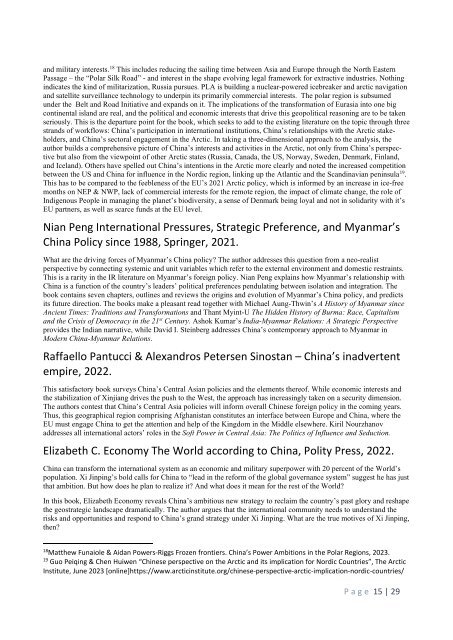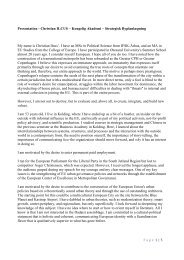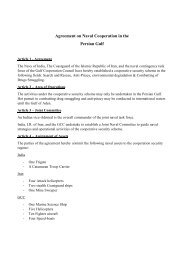china IR rev final sept 2023
This is the fourth and penultimate edition of my annotated bibliography on China international relations, art and Philosophy. from the books I distill policy relevant ideas for use and comsideration of policymakers after the ratification of the Cai, when the relatioship willl have to be managed
This is the fourth and penultimate edition of my annotated bibliography on China international relations, art and Philosophy. from the books I distill policy relevant ideas for use and comsideration of policymakers after the ratification of the Cai, when the relatioship willl have to be managed
Create successful ePaper yourself
Turn your PDF publications into a flip-book with our unique Google optimized e-Paper software.
and military interests. 18 This includes reducing the sailing time between Asia and Europe through the North Eastern<br />
Passage – the “Polar Silk Road” - and interest in the shape evolving legal framework for extractive industries. Nothing<br />
indicates the kind of militarization, Russia pursues. PLA is building a nuclear-powered icebreaker and arctic navigation<br />
and satellite surveillance technology to underpin its primarily commercial interests. The polar region is subsumed<br />
under the Belt and Road Initiative and expands on it. The implications of the transformation of Eurasia into one big<br />
continental island are real, and the political and economic interests that drive this geopolitical reasoning are to be taken<br />
seriously. This is the departure point for the book, which seeks to add to the existing literature on the topic through three<br />
strands of workflows: China’s participation in international institutions, China’s relationships with the Arctic stakeholders,<br />
and China’s sectoral engagement in the Arctic. In taking a three-dimensional approach to the analysis, the<br />
author builds a comprehensive picture of China’s interests and activities in the Arctic, not only from China’s perspective<br />
but also from the viewpoint of other Arctic states (Russia, Canada, the US, Norway, Sweden, Denmark, Finland,<br />
and Iceland). Others have spelled out China’s intentions in the Arctic more clearly and noted the increased competition<br />
between the US and China for influence in the Nordic region, linking up the Atlantic and the Scandinavian peninsula 19 .<br />
This has to be compared to the feebleness of the EU’s 2021 Arctic policy, which is informed by an increase in ice-free<br />
months on NEP & NWP, lack of commercial interests for the remote region, the impact of climate change, the role of<br />
Indigenous People in managing the planet’s biodiversity, a sense of Denmark being loyal and not in solidarity with it’s<br />
EU partners, as well as scarce funds at the EU level.<br />
Nian Peng International Pressures, Strategic Preference, and Myanmar’s<br />
China Policy since 1988, Springer, 2021.<br />
What are the driving forces of Myanmar’s China policy? The author addresses this question from a neo-realist<br />
perspective by connecting systemic and unit variables which refer to the external environment and domestic restraints.<br />
This is a rarity in the <strong>IR</strong> literature on Myanmar’s foreign policy. Nian Peng explains how Myanmar’s relationship with<br />
China is a function of the country’s leaders’ political preferences pendulating between isolation and integration. The<br />
book contains seven chapters, outlines and <strong>rev</strong>iews the origins and evolution of Myanmar’s China policy, and predicts<br />
its future direction. The books make a pleasant read together with Michael Aung-Thwin’s A History of Myanmar since<br />
Ancient Times: Traditions and Transformations and Thant Myint-U The Hidden History of Burma: Race, Capitalism<br />
and the Crisis of Democracy in the 21 st Century. Ashok Kumar’s India-Myanmar Relations: A Strategic Perspective<br />
provides the Indian narrative, while David I. Steinberg addresses China’s contemporary approach to Myanmar in<br />
Modern China-Myanmar Relations.<br />
Raffaello Pantucci & Alexandros Petersen Sinostan – China’s inadvertent<br />
empire, 2022.<br />
This satisfactory book surveys China’s Central Asian policies and the elements thereof. While economic interests and<br />
the stabilization of Xinjiang drives the push to the West, the approach has increasingly taken on a security dimension.<br />
The authors contest that China’s Central Asia policies will inform overall Chinese foreign policy in the coming years.<br />
Thus, this geographical region comprising Afghanistan constitutes an interface between Europe and China, where the<br />
EU must engage China to get the attention and help of the Kingdom in the Middle elsewhere. Kiril Nourzhanov<br />
addresses all international actors’ roles in the Soft Power in Central Asia: The Politics of Influence and Seduction.<br />
Elizabeth C. Economy The World according to China, Polity Press, 2022.<br />
China can transform the international system as an economic and military superpower with 20 percent of the World’s<br />
population. Xi Jinping’s bold calls for China to “lead in the reform of the global governance system” suggest he has just<br />
that ambition. But how does he plan to realize it? And what does it mean for the rest of the World?<br />
In this book, Elizabeth Economy <strong>rev</strong>eals China’s ambitious new strategy to reclaim the country’s past glory and reshape<br />
the geostrategic landscape dramatically. The author argues that the international community needs to understand the<br />
risks and opportunities and respond to China’s grand strategy under Xi Jinping. What are the true motives of Xi Jinping,<br />
then?<br />
18 Matthew Funaiole & Aidan Powers-Riggs Frozen frontiers. China’s Power Ambitions in the Polar Regions, <strong>2023</strong>.<br />
19<br />
Guo Peiqing & Chen Huiwen “Chinese perspective on the Arctic and its implication for Nordic Countries”, The Arctic<br />
Institute, June <strong>2023</strong> [online]https://www.arcticinstitute.org/chinese-perspective-arctic-implication-nordic-countries/<br />
Page 15 | 29








